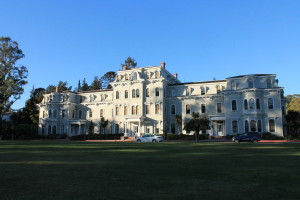
Five dancers gaze straight out to the audience in Lisser Hall, the Afro-pop music revealing the intense feeling of defiance radiating from the dancers in an MFA choreographed dance piece.
On March 16-17, the MFA dance performance showcased Yawen Zou, Brynn Ogilvie, Erik Lee and Bhumi Patel’s theses. The graduate students have worked on their pieces since the start of the school year under the guidance of dance professors Molissa Fenley and Shinichi Iova-Koga. In addition to the pieces, each choreographer has to do a written component.
Each piece is around 15-20 minutes long. The choreographer decides how much of the dance is set and how much is the dancer’s improvisation.
“They’re all coming from the same training style, but they’re all working in different ways,” Iova-Koga said. “[What] I like best about this evening and choreography in general is how different they are from each other.”
Iova-Koga said the four choreographers are all primarily using contemporary modern dance, but they each used the foundation in different ways.
“We all had our own ways of coming into it,” Lee said. “We found that isolation and community were very strong threads.”
For Patel, the actual feeling of the dance was important to capture, as she felt that lasts longer than any performance.
“The truth is no matter how radical our work is, it’ll disappear at some point,” Patel said. “I think about dance as ‘What can I make somebody feel?’ That’s almost more important than a step onstage.”
Zou had the first performance, “Natural Mind,” a meditation on the practice of Zen. Zou paired quick, stiff movements after slow, unfurling movements. The patterning and alternation on stage was well executed, even as the moves were sometimes disquieting, in the end circling back to the namaste position.
Ogilvie’s “how R u?” performance was second, with a piece that was inspired by a poem of Monica Prince. The first night there was a technical difficulty that forced the dancers to perform without music, which was resolved the next night.
“It was a very different piece without the sound,” Iova-Koga said. “It forced the dancers to listen to each other in space… It benefited them quite well.”
Patel presented two pieces, one choreographed by Anna Sokolow, and one by herself. Patel restaged Sokolow’s ‘Kaddish’ from the Labanotation Score, a system of documenting choreography. Her second piece, “Somewhere better than here/nowhere better than here,” explored how grief manifests in the body.
“My work is grounded in my study of grief,” Patel said. “What is the process to heal a physical body from grief?”
Lee’s “Moment Arc” flowed through different sections effortlessly, merging community and support in the steps.

“The impetus for my work was the media around so many young black men and women being killed,” Lee said. “It’s me honoring the people who have died of injustice before me.”
The last section of his dance was about coming together.
“The truth is we can only do so much by ourselves and we really do need each other,” Lee said. “We realize we have enemies, not necessarily people, but structures, ways of thinking.”
The title for the performance, “Footprint,” is what all four choreographers decided on, although it meant different things for each one of them. For Lee, it was an homage to choreographers who have influenced him, like Alvin Ailey and Bill T. Jones, as well as an homage for himself.
“I’m creating footprints just trusting that the marks people have made physically and socially continue in me,” Lee said. “I’m walking in their footprints as much as I’m creating new ones in this present day.”



